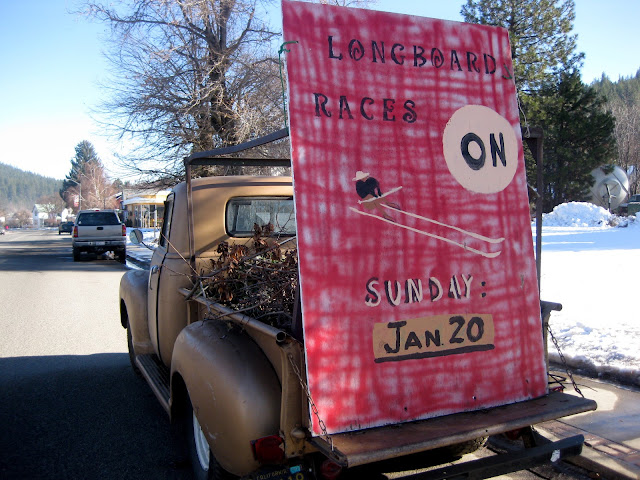Every so often on this blog I am compelled to throw in a post touting one of the unique local events our county has to offer. In the fall there is the quintessential apple press event and in the winter the longboard races help to keep us entertained.
If you are unsure what longboarding is, I will educate you. I know surfers use the term to describe long surfboards but here in Plumas County (nowhere near the ocean) longboards mean something else entirely. Longboards are long (12-16 foot) wooden skis. Downhill skiing apparently had its beginnings in these here hills. "In 1861, the first organized ski club races were held at Onion Valley, between Quincy and La Porte, giving birth to the sport of downhill ski racing in the western hemisphere." I got that quote off the Plumas Ski Club's website. The Plumas Ski Club promotes and sponsors the annual longboard races. You can check out their website here.
Our community college hosts a longboard making class where you can make your own wooden skis from local wood. My husband has taken the class twice and completed two pair of skis. They are beautiful.
On the third Sundays of January, February, and March there are races at an historic ski hill near Johnsville, Ca. One of the big goals of the Plumas Ski Club is to re-open this ski hill for the families of the surrounding communities to enjoy. Currently it is used for backcountry skiing, sledding, and the longboard races. The March race day is officially the WORLD championship because (as far as we know) it is unique in the world. The male and female winners on that day hold the title of "world champion longboard racer" until the following March.My husband races. That is him in the red.
 |
| It is almost impossible to turn so to stop you place a large pole between your legs and sit down on it to slow yourself. Dangerous business. |
Sometimes the races are cancelled due to not enough snow, too much snow, or super stormy weather. And then sometimes.......... as was the case on January 20, 2013, it is glorious. The day is bright and sunny, the snow is perfect for skiing, the crowd is in good spirits, and the sun warms your face. On those days, there is nowhere I would rather be than watching the races and cheering on the racers from the sidelines with friends.
 |
| A snapshot of the crowd with the historic lodge building in the background |
 |
| My husband is around 6 feet tall so you can see how long the skis can be. This was a practice day on the hill. |
 |
| Each race day, the racers pose for a group photo. Here is 1-20-13s. |
In other news, my friend from Bay St. Louis, MS sent me the link to a competition sponsored by Budget Travel magazine to determine the coolest small towns in America. They've narrowed it down to just 15 towns. Quincy, CA is one of them! As is Bay St. Louis. You can check it out and vote for your favorite here. Bay St. Louis is ahead of Quincy but I can't think why because there are no longboard races (at least not the skiing kind). They do however have an almost tropical island vibe that alludes us here in the Sierra Nevada mountains....
Enjoy!



















